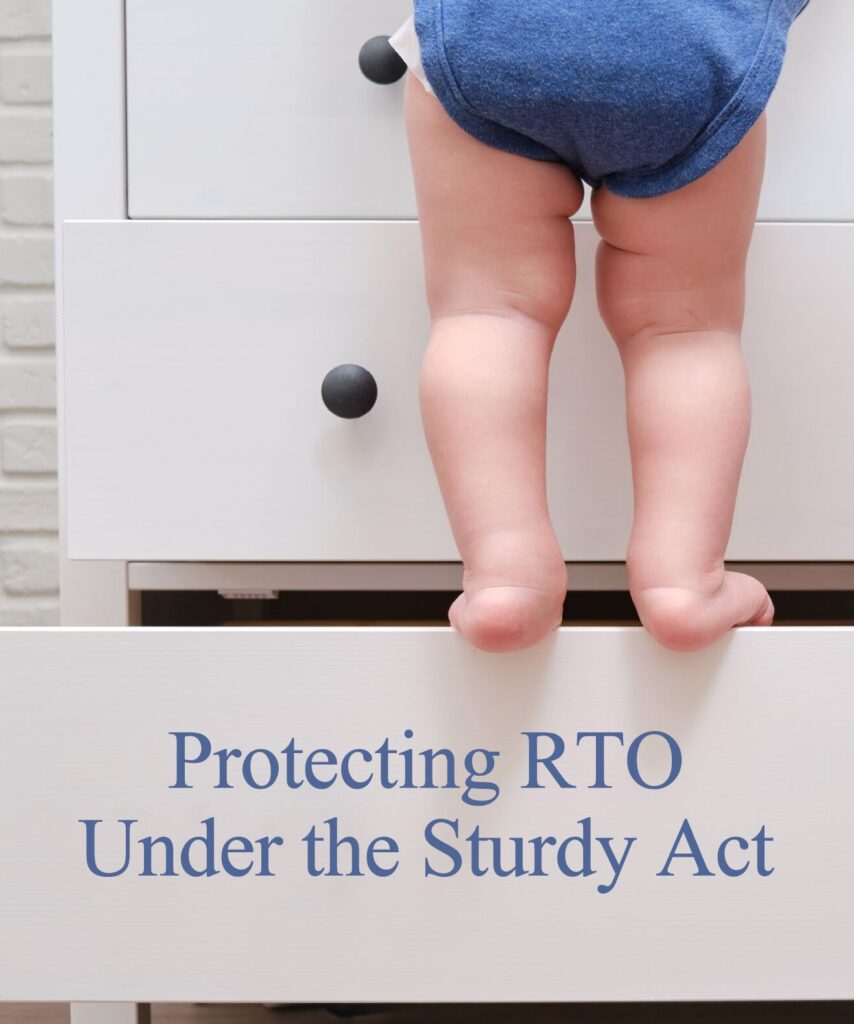THE LAW REQUIRES ALL DRESSERS MADE AFTER THE EFFECTIVE DATE AND MADE AVAILABLE IN THE U.S. TO PASS STABILITY TESTS AND ALSO HAVE ATTACHED WARNING LABELS IN THE FORMAT PRESCRIBED BY THE CPSC.
The Consumer Product Safety Commission (CPSC), created in 1972 under President Richard Nixon, is an independent federal agency whose mission has been to protect U.S. consumers against dangerous products. Over the years, the CPSC has issued and enforced regulations concerning bicycles, cribs, garage doors, refrigerators, residential fire prevention, stoves, and swimming pools, among other products.
Most recently, the agency has been concerned with what in government jargon are called “clothing storage units,” officially defined as “furniture items with drawers or hinged doors, intended for the storage of clothing typical in bedroom furniture, and which has all of the following characteristics: free-standing, height of at least 27 inches, mass of at least 30 pounds, and enclosed storage volume of at least 3.2 cubic feet.” The definition includes chests, chests of drawers, drawer chests, door chests, armoires, bureaus, chifferobes, and dressers. Most people just call them “dressers.”
The issue has been young children pulling out dresser drawers and standing on them in order to reach something farther up, and the furniture tipping over and injuring the child. You might remember that in 2016, IKEA recalled 29 million dressers after a fourth child had been seriously injured from a dresser tip-over accident. IKEA offered purchasers either a refund or a free wall-anchoring repair kit.
According to Furniture Today (“Senators write letter to HFA, other industry groups urging STURDY compliance,” October 2, 2023), the CPSC estimates an annual average of 22,500 emergency- room injuries due to furniture tip-overs, with 44% of those injuries involving children. And since 2000, there have been a total of 581 tip-over-related deaths, 81% of which were children.
Late last year, Congress enacted the STURDY – the Stop Tip-overs of Unstable, Risky Dressers on Youth – Act. The law orders the CPSC to create and adopt mandatory stability standards for dressers. The CPSC had just finished working with furniture manufacturers, consumers and their advocates, testing labs, and others to publish a voluntary Safety Standards for Clothing Storage Units. The agency concluded that its voluntary standards, with a few minor changes, met the dictates of the federal law and adopted it as the mandatory standards effective September 1, 2023, covering dressers completed on and after September 2nd.
The law requires all dressers made after the effective date and made available in the U.S. to pass stability tests and also have attached warning labels in the format prescribed by the CPSC. Some drawers are equipped with interlock devices that prevent more than one drawer from being opened at a time. This interlock system must operate without additional action by the consumer, and must keep drawers closed and retain function when subjected to 30 pounds of force for 5 seconds.
Manufacturers and importers of dressers must certify that their products comply with these standards and get a certificate of compliance from the agency.
Rental dealers aren’t manufacturing dressers, but they are renting them, and they will need to pay extra attention to the date of manufacture now that this new law is in effect.
But what to do about existing dressers – both units in the field and units in idle inventory? The good news is, APRO has no reported cases of rented dressers being involved in dresser tip-over injuries. Which may be because many, perhaps most, rental dealers are making sure all of the dressers they deliver have anti-tip, anchoring hardware delivered along with the units, along with instructions about how to use the hardware. And some dealers, in an extra effort to ensure the safety of their products (and customers), are training their delivery personnel on how to help customers install said anchors – directions can be found at www.anchorit.gov.
Ed Winn III serves as APRO General Counsel. For legal advice, members in good standing can email legal@rtohq.org.
———————————————
Dressers not equipped with interlocking devices must pass three stability tests:
1. Clothing load: Open all drawers if more than 50% of the storage volume is extended, fill the enclosed storage with 8.5 pounds per cubic foot of volume, and hold for 30 seconds.
2. Horizontal force: Apply 10 pounds of force on the highest hand-hold on the unit (not higher than 56 inches) for 10 seconds.
3. Carpet with child weight: Place a test block under the rear legs of the unit and hang a 60-pound test device on the front of the door most likely to cause tip-over for 30 seconds.










